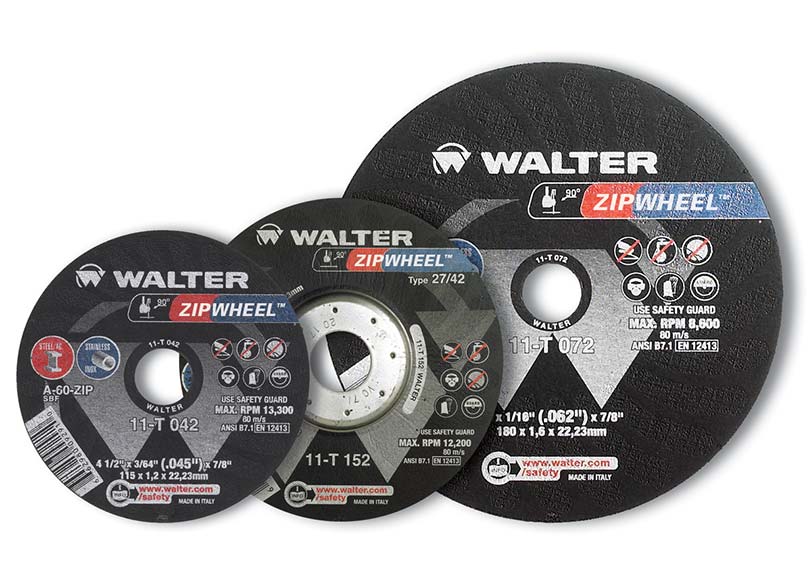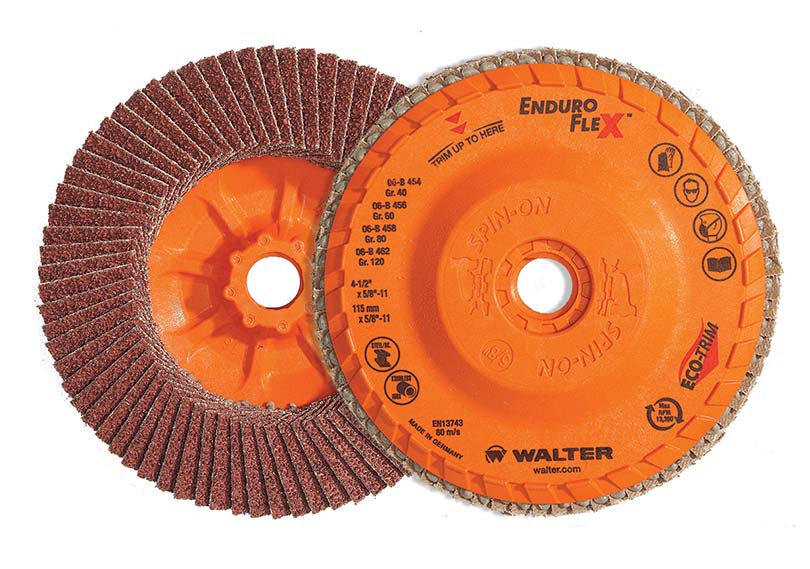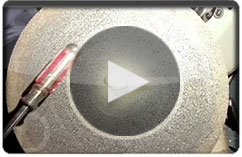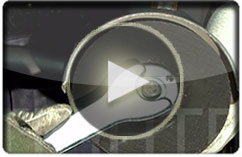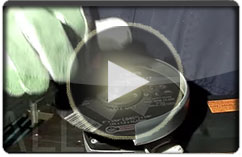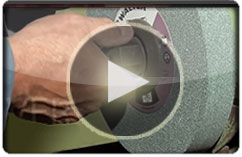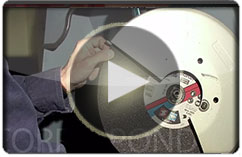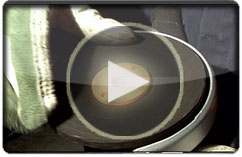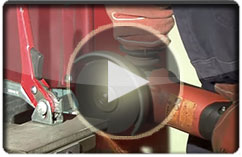OPERATING AND SAFETY INFORMATION FOR THE USE OF RESIN-BONDED ABRASIVE PRODUCTS - GENERAL
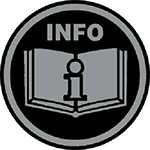
MSDS available at http://www.walter.com
Operator's manual of the machine on which the abrasive will be used on
ANSI B7.1: American National Standard Safety Requirements for the use, care and protection of abrasive wheels (www.ansi.org)
Requirements for the use, care and protection of abrasive wheels (www.ansi.org)
EN12413: Safety requirements for bonded abrasive products (www.cen.eu)
IMPORTANT: OPERATING AND SAFETY INFORMATION
Abrasive products can generate hazardous situations and cause accidents if not used in a correct and conscious way. Before using abrasive wheels, carefully read the following safety guidelines, the regulations indicated on product label and instructions in boxes. These guidelines are not exhaustive; refer to “further information” section for complete information.
Users need to apply all the laws and decrees in force in their country and particularly the ones regarding safety at work (ex. OSHA), National Technical Standards (ex. ANSI), International Standards (ex. EN, ISO), the operating and safety instructions of grinders on which abrasive wheels are mounted and, for accessories used with wheels (flanges, locking keys, backing pads, etc.).
READ CAREFULLY AND SHARE WITH ALL OPERATING PERSONNEL
This document, the above laws and sources must be shared with all personnel involved in handling and/or using abrasive wheels. Make sure that all personnel clearly understand the information. These rules and regulations must be considered and followed by all users of abrasive products.
IMPORTANT: RECALLS OF PRODUCTION BATCHES
Before using an abrasive product, check our website at www.walter.com/safety to make sure that your production batch has not been recalled. If your batch is listed, do not use the wheels and keep them in a different area with a clear mention DO NOT USE indicated on the box. Immediately contact our customer service by e-mail, telephone or fax.
IMPORTANT: DANGERS
Abrasive wheels are relatively fragile so they must be handled and used with care. Wheels that have already been used, are incorrectly mounted, damaged or misused can cause serious accidents or injuries. Cutting, grinding and polishing operations can set dangerous contaminants in the air that can be harmful to health. Use appropriate dust/fumes collecting systems and wear personal protection equipment for respiratory tract.
Walter bonded abrasives are manufactured in compliance with:
EN12413: European regulation
ANSI B7.1: US regulation
Topics
Further information can be found from:
- United Abrasives Manufacturers Association (UAMA) (www.uama.org) that publishes very useful and complete booklets
- ANSI B74.2: American National Standard Specifications for shapes and sizes of grinding wheels and for shapes, sizes and identification of mounted wheels (www.ansi.org).
- ANSI B74.13: American National Standard Markings for identifying grinding wheels and other bonded abrasives (www.ansi.org).
- Federation of European Producers of Abrasives (FEPA) (www.fepa-abrasives.org) that publishes very useful and complete booklets
- ISO525: Bonded abrasive products - general requirements (www.iso.org).
- ISO 19432: Building construction machinery and equipment -- Portable, hand-held, internal combustion engine driven cut-off machines -- Safety requirements and testing (www.iso.org).
- EN 792: Hand-held, non-electric power tools - Safety (www.cen.eu).
- EN 13218: Machine tools - Safety (www.cen.eu).
- EN 50144: Safety of hand-held electric motor operated tools. General requirements (www.cenelec.eu)
Walter labels basic safety information:
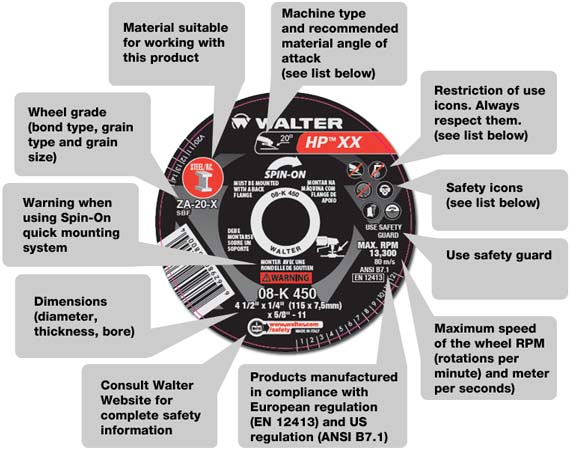
DO NOT use if damaged
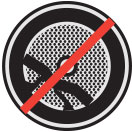
- Inspect packaging for any damage, distortions, etc. that could have been caused by shipping and handling.
- Refuse suspect deliveries and inform supplier of damaged packaging.
- Handle and transport abrasive wheels with care as they are relatively fragile and avoid shocks and falls.
- Stock abrasive wheels in a dry environment at temperatures between 5°C (41°F) and 45°C (113° F). Do not expose wheels to intense cold or sudden temperature changes, high humidity conditions, water and chemical products such as solvents.
- Store wheels in a proper way on special shelves, never on the ground or where there is a possibility they will get damaged; either kept in the working area, on shelves or hung on the wall.
- Use the FIFO method to use the abrasives (First in, first out).
- Do not leave wheels mounted on grinders if they are not in use, especially if they are left unattended. Store partially used wheels on shelves or hang them on the wall.
- Do not stack them too high or heavy, especially thin cutting discs or particularly fragile or delicate wheels.
- When mounting the wheel, check for cracks or damages. Do not use damaged wheels that have accidentally fallen or if they are already used, look too worn.
- Carry out the ring test. The test consists in lightly striking one side of the disc with a non metal object (e.g.: screwdriver handle). If the sound is deep or dull, it means that the product is probably cracked and needs to be rejected.
Video: How to make a ring test
- For an adequate choice of abrasive wheels, consult our catalogue and our guide on our website at www.walter.com
- Never use wheels that have a higher diameter than the one shown on the grinder label or in the grinder's instructions manual.
- Make sure that the size and shape of the wheel correspond to those intended for the grinder used.
- Use abrasive wheels only and exclusively with the grinders for which they have been intended and use on suitable metals only.
- Walter uses a color coding system on its labels to ease up wheel / material selection

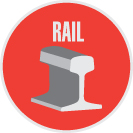
Red for steel
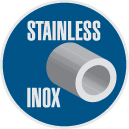
Blue for stainless steels and nickel based alloys
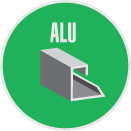
Green for aluminum and non-ferrous metals
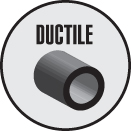

Grey for concrete and ductile

Black for plastic
- Always respect the restrictions of use shown on the label of the wheels.
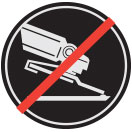
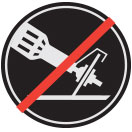
NOT suitable for grinding
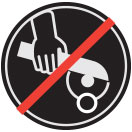
NOT suitable for hand-held grinders
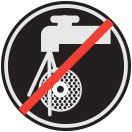
DO NOT use for wet grinding or cutting
- Verify that the maximum RPM of the grinder used is always and in any operating condition, lower than or equal to the maximum speed shown on the wheel label.
- Make sure the grinder does not exceed the maximum operating speed of the abrasive wheel/disc (grinders with automatic speed adjustment proportional to the disc diameter).
- Check with a tachometer that the rotating speed of the grinder corresponds to that shown on its plate. If not, do not use the grinder and have it fixed.
- Ex. MAX RPM. 12 200 80 m/s ;
- Before mounting or dismounting an abrasive product, disconnect the power source of the grinder (electric power, compressed air, etc.).
- For shaft mounted abrasives speed on abrasive refers to a maximum overhang of 1/2". Over 1/2" overhang, reduce speed.
Video: How to mount an abrasive wheel
Video: How to mount a cutting wheel
Video: How to mount a bench grinding wheel
Video: How to mount a large cut-off wheel
- In order not to damage the wheel while mounting them, avoid clamping with too much pressure.
- Never force wheels while mounting. If the wheel arbor hole is too small for the arbor, do not force as an excessive pressure will damage the wheel.
- Check that the arbor hole size on the wheel’s label corresponds to the one shown in the grinder’s instruction manual.
- Do not mount wheels with an arbor hole that is not compatible with the arbor as this situation could generate strong vibrations and be very dangerous.
- Do not mount more than one wheel on the same arbor.
- Never use a Type 1 (EN 41) flat wheel with a depressed center back flange
- Some types of wheels are equipped with a blotter that needs to be mounted between the flange and each side of the wheel before tightening to avoid slippage, compensate slight irregularities of the surface of the flange and wheel, and decrease wear of flange. It is made of soft material (e.g. paper or cardboard) and must be of a slightly larger diameter than the flange used. Always use a new blotter.
- Wheels for bench grinders are equipped with a work rest that need adjustment before use at a distance not more than 3mm (1/8”) from the wheel and should not touch the wheel when it turns.
(The subject-matter of flanges and the relevant mounting procedures is extensive and lies outside the contents of this manual. The grinder must be equipped with correct flanges in conformity with the regulations and instructions on the grinder. Detailed information can be supplied by the grinder manufacturer or links listed in this document.)
- Check that the clamping nut is fully engaged with the corresponding arbor thread.
- Check that the flange is flat, clean, smooth, not worn and without burrs.
- Always use appropriate dimension and shape of flange for the wheel/disc to be mounted.
- Make sure back flange sits flat on grinder spindle shoulder.
In any case, the main rules for flanges on portable and fix grinders are the following:
- Flanges must have the same diameter and shape (recesses) facing down to the wheel.
- Flanges for abrasive wheels and cutting discs normally have a diameter of at least 1/3rd of the wheel’s diameter.
Exceptions:
- Depressed center and reinforced wheels (type 27) for grinding with portable grinders.
- Conical reinforced wheels (type 28) for grinding with portable grinders.
- Semi-flexible reinforced wheels (type 29) for grinding and finishing with portable grinders.
- Depressed center and reinforced cutting wheels (type 42 /27) for cutting with portable grinders.
- Reinforced and flat cutting wheels (Type 41 / Type 1) for cutting with portable grinders (up to diameter 230mm included).
- Mounted wheels, portable cup, cone or plug wheels with threaded inserts.
Where flanges must have the following dimensions: General guidelines (refer to Ansi B7.1, EN 12413 and FEPA for complete guidelines).
| FEPA | USA (ANSI B7.1) | |||
| diameter | European standard | Type 1 cutting | T27, 28 and 29 | portable cup, cone or plus with threaded insert |
| 1" | 5/8" | |||
| 2" | 19mm | 12.5mm (1/2") | 16.5mm (11/16") | 1" |
| 3" | 19mm | 20mm (3/4") | 20mm (3/4") | 1" |
| 4" (3/8" arbor hole) | 19mm | 25mm (1") | 20mm (3/4") | 1-3/8" |
| 4" (5/8" arbor hole) | 32mm | 25mm (1") | 28mm (1-3/32") | 1-3/8" |
| 4-1/2" | 41mm | 29mm (1-3/16") | 38mm (1-1/2") | |
| 5" | 41mm | 32mm (1-1/4") | 41mm (1-5/8") | 1-3/4" |
| 6" | 41mm | 38mm (1-1/2") | special adaptors | 2" |
| 7" | 41mm | 45mm (1-3/4") | special adaptors | |
| 9" | 41mm | 58mm (2-1/4")* | special adaptors | |
*use clamping flanges no. 30-B 022
In USA (ANSI B7.1): General rule for type 1 cutting wheels, flanges should cover at least ¼th of the wheel diameter.
Special adaptors for type 27 (depressed center), 28 (conical shape) and 29 (saucer shape) wheels with diameters higher than 5” are mandatory in US. The rear flange (adaptor) has to extend beyond the area of the depressed center and support the side of the disc when a side pressure is exerted during grinding. Adaptor nut (clamping nut) is less than 1/3rd of diameter & fits in the depressed center of the wheel to prevent interference with the work piece. When using this type of flange, pay particular attention to the following points:
- There must be a slight clearance between the most external part of the rear hub and the wheel's surface afte clamping to ensure that a blocking pressure is exerted only in correspondence with the center hub.
- The periphery of the hub face should be in contact with the wheel’s surface only when this bends under load.
- Do not use blotters when mounting these types of flanges.
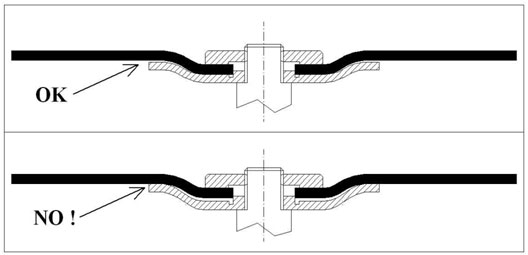
Avoid dangerous clamping conditions as shown in the illustration on the right below.
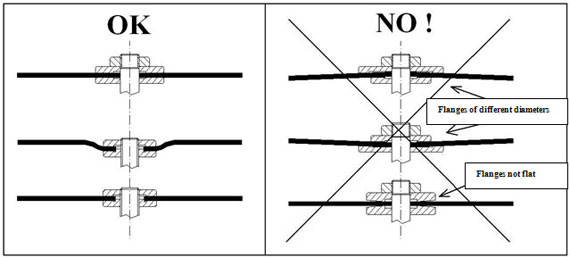
Video: How to mount a Spin-on wheel

- Wheels must be mounted with a back flange that must be clean and of equal or larger size than Spin-On nut.


- Wheels need to be installed with raised portion towards the back flange (like ALL other depressed center wheels).

- Thread all the way through until the back of the wheel sits flat on the back flange.
- Make sure at least 4 threads are fully engaged with the spindle.
- Inspect wheel threads and machine threads before mounting to make sure they are not damaged or worn.

- Avoid bringing the polymer nut in contact with the work piece.


- Do not use when threads are worn or damaged.
- Do not cross thread or force the wheel on the machine’s arbor.
- Make sure the type of thread of the grinder arbor and the wheel’s threaded arbor hole are compatible (M14 - 5/8”).
- Do not remove and re-use polymer nut on another wheel.
- Thread all the way through until the back of the wheel sits flat on the back flange.
- Make sure all threads are fully engaged with the spindle.
- Inspect wheel threads and machine threads before mounting to make sure they are not damaged or worn.
Video: How to safely operate an angle grinder with a thin cutting wheel
- After mounting the abrasive wheel/disc, make sure that it rotates freely by manually making it turn before starting the grinder.
- Check that the wheels are completely contained within the safety guard. Pay particular attention to high thickness wheels, conical shape (type 28) or when using a thick clamping nut.
- Firmly fix the work pieces before starting any work
- Always firmly hold grinders with both hands.
- Before using the abrasive product, make sure of the proper installation and blocking of the safety guard, remove any foreign object, start the grinder and let it turn for at least 30 seconds without contact with the material. During this test, always keep the open area of the safety guard oriented towards the opposite direction of the operator and never towards other people present in the same area. In case anomalies, vibrations or irregular rotation occur, let the grinder stop naturally, remove the abrasive wheel/disc, check its correct assembly and if the problem persists, reject the wheel and inform the supplier of the problem.
- When cutting pieces made of an assembly of parts joined together or parts with a difficult geometry, make sure to look around the not visible parts as these parts could push and stress the disc dangerously and even break it.
- When cutting or grinding composed parts (soldered, bolted, nailed, jointed), it is possible that the cut frees residue stresses inside the parts or sets parts in motion. This situation can be dangerous (ask for the opinion and the approval of a structural engineer in order to evaluate the consequences of cutting/grinding operations).
- Cutting or grinding operations on parts subject to forces (gravity, elasticity, hydrostatic pressures, fluid dynamics pressures, etc.) can violently set parts in motion. (Ask for the opinion of a specialized engineer before doing this type of operation).
- Do not use abrasive products in presence of combustible or flammable material (organic, inorganic, metallic) and/or physical (solid, liquid, gas, powder) whether they're in an open environment or contained in barrels, tanks or tubes. It is recommended to always keep a fire extinguisher nearby.
- Do not use abrasive materials to grind and/or cut holders, tanks or tubes that have contained combustible, flammable or explosive products (solid, liquid or gas).
- If the abrasive product or the grinder generate bothersome vibrations, stop using them, replace the abrasive wheel/disc, verify the condition of grinder, equipment and that the work piece is well fixed.
- If a wheel/disc gets too worn on the sides during use, stop using it and reject it.
- When a cutting or grinding disc has decreased to 3/4 of its diameter, it must be rejected and replaced with a new one.
- Never allow the work piece to wear the area of the depressed center (with depressed center wheels) or touch clamping nuts.
- Operate grinder in a way that sparks fly away from face and body of personnel in the surrounding area.
- Always use safety common sense with abrasive products
Types 27, 28 and 29 grinding wheels of must not be used with an either too low or too high angle to the work piece.

Type 27 grinding ideal angle varies from 15° to 30°

Type 29 ideal angle is 10°

Type 28 ideal angle is lower than 10°

Type 27 combo (cutting and grinding) wheels ideal angle is of 90° or 20°
The only permitted angle for cutting wheels is of 90° to the material
(Type 1 (EN 41) –flat)







Type 27 / (EN 42) – depressed centered)

 Eyes, face, ears and lungs protection
Eyes, face, ears and lungs protection Eyes / Face: Sparks generated during grinding/cutting applications can cause serious damage to eyes and skin. It is recommended to wear suitable eye and face protections, masks or shields that cover the whole face, combined with goggles or glasses. Evaluate specific hazards and select appropriate protection accordingly. Refer to Ansi Z87.1 (American national standard /occupational & educational personal eye and face protection devices).
Protection of hearing: The noise generated by abrasive products can exceed 80 dBA. A prolonged exposure to the noise generated while using abrasive products can cause permanent damage to the auditory system of the operator and personnel in surrounding working area. Always carry out an evaluation of the noise risk associated to the use of abrasive products and use suitable precautionary and protective measures such as ear plugs, anti-noise screens, etc.
Protection of respiratory tract: Abrasive products and work pieces can generate or release particles, powders, fumes or vapors harmful for health. An excess of these contaminants in the air can cause irritations and permanent damage to eyes, skin and respiratory tract. It is compulsory to always carry out an evaluation of the physical and chemical risks associated with the use of abrasive products and adopt the suitable protective measures.
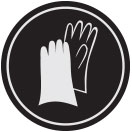 Hands protection
Hands protection Protection of hands and arms: Splinters, sparks, fragments, hot parts or burrs generated while grinding/cutting, or handling wheels or work pieces can burn, cut or irritate the skin. Wear heavy leather protective gloves that also cover forearms and wrists.
Splinters, sparks, fragments, hot parts or burrs generated while grinding/cutting, or handling wheels or work pieces can burn, cut or irritate the skin. Wear heavy leather protective gloves that also cover forearms and wrists.
- Wear resistant and fireproof clothing, hats or head protections, thick leather aprons and safety shoes. Never leave uncovered body parts while working. Clothes worn by the user have to cling to the body in order not to get entangled in the wheel or against the work pieces. A cloth that is dragged by the wheel or grinder can cause serious injuries.. Also, personnel not directly using abrasive products but present in the working area should wear suitable protection equipment.
Protection from vibrations: Abrasive products and grinders on which they are used can generate vibrations. The prolonged exposure to vibrations can cause physiological damages to the operator from loss of sensitivity and ability of the fingers, hands and arms, tingling and numbness, pains, rigidity, inflammation of tendons, muscles and ligaments up to permanent inabilities.
The entity of these symptoms depends on:
- Type and level of exposure
- Duration of exposure
- Condition and types of wheels, grinders and accessories used (flanges, backing pads, etc.).
- Working conditions
It is therefore recommended to keep grinders, equipment and flanges in efficient conditions and replace obsolete grinders with high vibration levels, by newer grinder models with low vibration and by using balanced abrasive products while adopting suitable and protective measures.
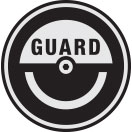 Use safety guard
Use safety guard
Exclusively use grinders provided with suitable safety guard and verify that they are safe and in good condition. Safety guards have to be well structured and withstand shocks of pieces of wheels projected if it should burst. They must cover half the wheel surface from both sides of the wheel and leave enough uncovered to carry out the work. The open part of the safety guard has to be oriented towards the opposite of the operator. If safety guards are adjustable, they must always be mounted in order to protect the user from sparks, fragments and, in case of burst, from pieces projected from the wheel by centrifugal force. Do not modify safety guards. In case of doubts, contact the manufacturer or distributor of the grinder. Safety guards must comply with regulations EN792, EN13218, EN 1454, EN50144, ANSI B7.1, CSA-C22.2 (UL 60745-2-3).
Guards for shaft mounted abrasives
Guards are required for wheels (any of these conditions):
- More than 3” diameter
- More than ¼” thick
- Faster than 9500SFM (45 m/s) (ex. More than 18000RPM for 2”)
Verification of grinder and equipment: Many accidents occur because of faulty or worn grinders. Always check the maintenance schedule of grinders and equipment (flanges, backing pads, pivots, adaptors, etc.) before mounting abrasive products, especially if it has not been used for some time.
Electrical protection: Avoid using electrical grinders in presence of wet pavements, rain or high humidity conditions. Pay attention not to damage or crush the electrical cable of the grinder. If the cable is damaged, do not use the grinder. Static electricity generated by the rubbing of abrasive products on work piece can cause electric discharges.
Environment and working conditions:
- Avoid uncomfortable, dangerous positions of instability, repeated stress of particular body parts of the operator, avoid unnecessary bending, always be in a stable position in case of sudden and/or heavy stresses originated by the use of the grinder.
- Assure appropriate lighting
- Keep the working environment at comfortable temperatures and humidity
- Keep air circulation in the working environment
- Keep working area clean and free of obstacles. Make sure the floor is not slippery (wet, greasy, frozen, covered with snow, etc.).
- Always check for incandescent particles that can be directed or emitted, and check that they will not cause fires, damages, injuries, etc.
- Remove all combustible, flammable or explosive materials from working area.
- Use collective protection devices such as shields, screens and anti-noise barriers.
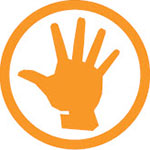 Do not:
Do not:
- Allow untrained personnel to handle, store, mount or use abrasive products.
- Mount or remove an abrasive product before the grinder has come to a complete stop and unplugged from its power source (electric energy, compressed air, oil pressure, etc.).
- Use wheels if you are not sure of the previous stocking conditions, if they were left unattended or taken from the rubbish or of doubtful origin.
- Wet abrasive wheels and do not use them if they have been exposed to high humidity or liquids.
- Use dropped, damaged, broken, too worn wheels or that seems to be used in an incorrect way or the consumption is irregular.
- Use abrasive wheels on grinders rotating at a higher speed than shown on the disc or on grinders that do not show their rotating speed on their plate.
- Mount wheels of a different diameter/type than the one marked on the plate and/or grinder’s instructions.
- Try to force mounting, alter or enlarge the arbor hole size of wheels. If the arbor hole is not suitable, choose another wheel with a correct size.
- Tighten nuts with excessive torque or using a hammer or lever.
- Use wheels without suitable flanges, with damaged/dirty flanges or where surfaces are not perfectly flat.
- Re-use built-in nuts or flanges (metal or plastic type) on other wheels.
- Use abrasive wheels for different applications than the one for which they were manufactured and/or on different materials than those for which they were designed.
- Use cutting discs (ex. type EN 41 and 42) for grinding. Do not apply side pressure to cutting discs. Do not use cutting discs to cut curves.
- Use grinding discs (type EN 1, 27, 28, 29) for cutting.
- Mount more than one wheel on the same arbor.
- Use grinding wheels on the wrong side.
- Grind with the side of a disc/wheel unless it is expressly designed for this application.
- Start the grinder if the abrasive product is in contact with the work piece or with any other object.
- Stand in the axis of rotation of the wheel when starting the grinder
- Use grinders or abrasive wheels that generate excessive vibrations.
- Hit the wheel on the work piece or vice versa.
- Abuse or jam wheels in the works
- Hold the work piece with the hands while working on it.
- Remove or modify safety guard and do not use the grinder if the guard has not been re-positioned, adjusted and firmly locked.
- Remove handles from portable grinders.
- Modify abrasive products in any way.
- Use discs without personal protection equipment such as goggles, mask, ear protection, apron, gloves, etc.).
- Use abrasive products in presence of combustible or flammable materials.
- Use abrasive products near other people if they are not wearing protections.
- Use abrasive products in environments without suitable powder/fume ventilation and suction devices.
- Allow abrasive products to overheat. Too high temperatures could damage the product’s structure and make it dangerous.
- Overheating can be generated by:
- Grinding /cutting on non-conductive materials
- Grinding/cutting on too hot or incandescent materials
- Excessive pressure applied on the abrasive product
- Bad or not suitable cutting with the abrasive product
- Clogging
- Overheating can be generated by:
 Must do's
Must do's
- Use care when handling abrasive wheels as they can be damaged
- Consult MSDS for each product involved in the grinding process
- Visually check the wheels for damages and make a ring test before mounting
- Ensure that damaged, defective and worn-out wheels are destroyed to prevent their usage
- Make sure machine speeds does not exceed operating speed on wheel package
- Wheel hole fits on machine arbor properly and that flanges are clean, flat and of equal size and of the proper type for wheels being mounted.
- Use mounting blotters when supplied with wheels
- Always use a properly designed safety guard covering at least one half of the grinding wheel and ensure guard is correctly positioned
- Wear suitable protective clothing
- Always wear protective glasses and additional eye and face protection if required
- Grind with proper ventilation, employ dust controls and or protective measures appropriate to the material being ground
- Always firmly hold grinders with both hands.
- Make sure work piece is secured to make sure it will not move in operation
- Rotate the wheel manually to ensure that it runs freely before turning on the grinder
- Run the wheel for at least 30 seconds at operating speed after mounting before working.
- Stay outside the axis of rotation of the wheel when doing this.
- Make sure other people in the same area are protected from sparks and debris
- Stop using or replace a wheel if there is too much vibration in the operation.
- Be sure the work rest is properly adjusted on bench grinders (should be centered with wheel & no more than 1/8” away from wheel)
- If possible, cut solids with a moderate rocking motion to dissipate heat
Disposal of abrasive products must be done in conformity with the laws in force in your country and always by respecting the environment. In order to dispose, it may be necessary to have the product’s Material Safety Data Sheets (MSDS). Products to be disposed must be broken into pieces to be sure it will not be used.
Personnel involved in operations, orders, transportation, stocking, handling, assembly, use, disassembly, disposal of abrasive products must be trained on all subjects referring to safe use of abrasive products. It is important that the information (instructions, booklets, tables, etc.) be accessible to all personnel at all times. Keep and update a registry of the personnel trained.
Participation to special training courses is highly recommended. Walter supplies free safety seminars upon demand. Contact your local Walter rep for more information.
- Basic security measures for grinding wheel use - PDF document 242 Kb.
- Basic security measures for use of Zip Wheel - PDF document 378 Kb.
- Troubleshooting guide - PDF document 12 Kb.
The content of this document is protected by copyright. Distribution is permitted and encouraged. However, modifications, omissions and reproductions are absolutely forbidden.
Walter Surface Technologies’ bonded abrasives products are complying to the highest standards of the industry, namely ANSI B7.1, “Safety requirements for the Use, Care and Protection of abrasive wheels in North America” and EN12413, “Safety requirements for bonded abrasives products”. The EN12413 standard mentions in A.1.2.2 that “Abrasive products with type of bond B and BF for use on hand-held machines (except mounted points and wheels, plugs and cones) shall be marked with a date of expiry. The date of expiry shall be within three-years (3) from the date of manufacture. It shall be expressed as month and year e.g. V04/2021”. Particular products (spinon , aluminum hub wheels, etc) could bear the expiry on the product label through notches made on the label periphery in correspondence of the proper pre-printed expiry month/year. This recommendation assumes that bonded abrasive products have been stored under ideal storage conditions.
SAFETY GUIDE FOR GRINDING AND BLENDING USING COATED ABRASIVES

IMPORTANT SAFETY INFORMATION, POST NEARBY YOUR MACHINE
WARNING! Improper use of coated abrasives may cause breakage and serious injuries. Comply with ANSI B7.1 (American National Standard Institute Requirements for the use, care and protection of abrasive wheels), EN 13743 (Safety requirements for bonded abrasive products) and all by-laws in force in your country.
Grinding operations can spread dangerous contaminants in the air, which can be harmful for the health. Use proper dust/fumes collectors and wear personal protective equipment for respiratory tract.
WARNING! This product can expose you to chemicals including Formaldehyde which are known to the State of California to cause cancer.For more information go to www.P65Warnings.ca.gov.
IMPORTANT: READ CAREFULLY AND SHARE WITH ALL OPERATING STAFF
This document, the above standards and laws must be shared and understood by all personnel involved in handling and/or using abrasive wheels.
BEFORE USING, READ:
- This safety manual including the section covering the warning icon description
- SDS (Safety Datasheets) available at http://www.walter.com
- Operator’s manual of the machine on which the abrasive will be used on
The following guidelines are not exhaustive. For further information on the safe use of products sold by WALTER, visit our website at www.walter.com/safety or contact your nearest Walter office.
Walter coated abrasives are manufactured in compliance with: EN13743, ANSI B7.1
Topics

- DO NOT use if damaged

- Use safety guard

- Wear heavy leather protective gloves

- Wear suitable eye and face protections (hearing and respiratory protection)
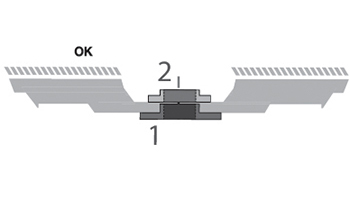
- 1: Machine backing flange
- 2: Clamping nut
- When operating flap discs with slim shaped backings and arbor hole, use the flat side of the clamping nut!
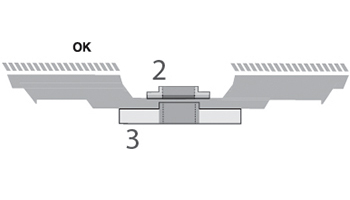
- 2: Clamping nut
- 3: For power tools with longer spindle shaft
- Use the universal back flange to adapt to the height of the guard. 30-B 016 for M14 spindle and 30-B 017 for 5/8"-11 spindle.
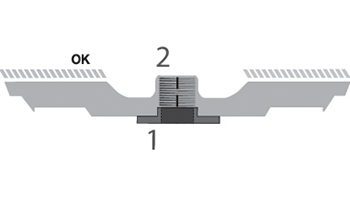
- 1: Machine backing flange
- 2: Spin-on thread
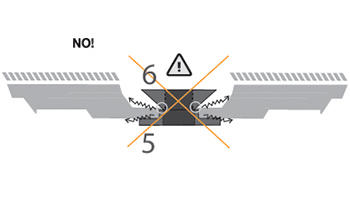
- 5: Machine backing flange
- 6: Conical clamping nut
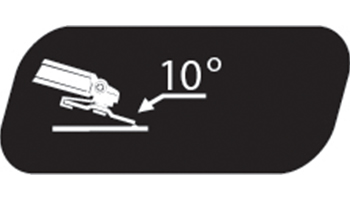
- Ideal grinding angle may vary from 5° to 15°
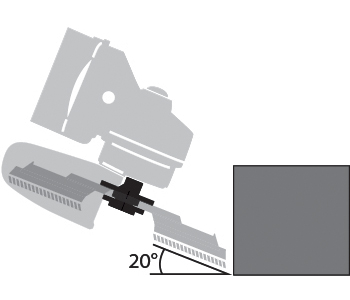
- Trim your disc on a sharp metal edge
- Trimming may only occur with an angle between 15 to 30 degrees
- Apply light pressure and increase gradually until the backing starts to trim
- Keep that pressure until you uncover 1/4" (6mm) of the flaps. Trimming more than 1/4" (6mm) at a time may compromise the flap disc’s integrity.
- Beware not to cut the flaps. Stop when you start to see the white adhesive that holds the flaps.
 Do not:
Do not:
- Allow untrained personnel to handle, store, mount or use abrasive products.
- Mount or remove an abrasive product before the grinder has come to a complete stop and unplugged from its power source (electric energy, compressed air, oil pressure, etc.).
- Use discs that have been dropped, damaged, broken or excessively worn or discs that seem to have been used improperly or if the disc's abrasive flaps are damaged.
- Use abrasive discs on grinders rotating at a higher speed than maximum speed specified on the disc.
- Use on grinders that do not show their rotating speed on their rating plate.
- Try forcing the mounting, alter or enlarge the wheel arbor hole size. If the arbor hole is not suitable, choose another back flange or disc with the right size.
- Use excessive torque, a hammer or lever to tighten nuts.
- Use discs without suitable flanges, with damaged/dirty flanges or where surfaces are not perfectly flat.
- Use abrasive discs for applications other than the one for which they were manufactured and/or on different materials than those for which they were designed for.
- Use grinding discs for cutting. Do not apply frontal pressure to grinding discs.
- Mount more than one disc on the same arbor.
- Grind using the side of a disc unless it is expressly designed for this application.
- Stand in the disc axis of rotation when starting the grinder.
- Use grinders or abrasive discs that generate excessive vibrations.
- Abuse or jam discs while in operation.
- Remove or modify the safety guard and do not use the grinder if the guard has not been re-positioned, adjusted and firmly locked.
- Use discs without personal protective equipment such as goggles, mask, ear protection, apron, gloves, etc.).
- Use abrasive products in the presence of combustible or flammable materials.
- Use abrasive products near other people if they are not wearing their protective equipment.
- Use abrasive products in environments without suitable powder/fume ventilations and suction devices.
 Must do's
Must do's
- Use care when handling abrasive wheels as they can be damaged
- Consult MSDS for each product involved in the grinding process
- Visually check the discs for damages and make an integrity test before mounting.
- Make sure machine speed does not exceed the operating speed shown on disc package or backside.
- Ensure that the disc hole properly fits on machine arbor and that flanges are clean, flat, of equal size and of the proper type for wheels being mounted.
- Always use a properly designed safety guard covering at least one half of the grinding disc and ensure guard is correctly positioned.
- Wear suitable protective clothing.
- Always wear protective glasses and additional eye and face protection, if required.
- Grind with proper ventilation, use dust controls and/or protective measures applicable to the material being grinded.
- Always hold grinders firmly with both hands.
- Run the disc for at least 30 seconds at operating speed after mounting before operating. Stay away from the wheel axis of rotation when doing this performance.
- Spin-On discs must be mounted with a clean back flange that is a size equal or larger than the Spin-On nut.
- Spin-On discs need to be installed with the raised portion towards the back flange (like ALL other depressed center wheels and discs).




